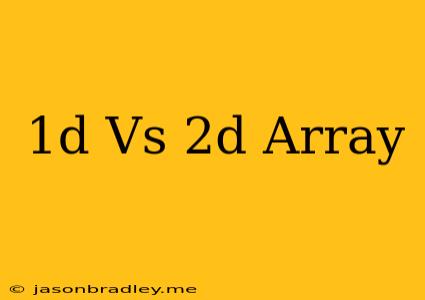Tentu, berikut artikel tentang 1D vs 2D array:
1D vs 2D Arrays
In computer programming, an array is a data structure that stores a collection of elements of the same data type. The elements are stored in contiguous memory locations, which allows for efficient access and manipulation of the data. There are different types of arrays, one of the most common classifications being one-dimensional (1D) and two-dimensional (2D) arrays.
One-Dimensional Arrays (1D Arrays)
A one-dimensional array is a linear collection of elements, where each element is identified by a unique index. The index is an integer that starts from 0 and goes up to the size of the array minus 1.
Example:
int numbers[] = {1, 2, 3, 4, 5};
In this example, numbers is a 1D array of integers. The array has 5 elements, and each element can be accessed using its index. For instance, numbers[0] refers to the first element (1), numbers[1] refers to the second element (2), and so on.
Two-Dimensional Arrays (2D Arrays)
A two-dimensional array is a collection of elements arranged in a tabular form, with rows and columns. Each element is identified by two indices: a row index and a column index.
Example:
int matrix[2][3] = {
{1, 2, 3},
{4, 5, 6}
};
In this example, matrix is a 2D array of integers. It has 2 rows and 3 columns. The element at row 0 and column 1 is matrix[0][1], which has a value of 2.
Differences Between 1D and 2D Arrays
Here are some key differences between 1D and 2D arrays:
| Feature | 1D Array | 2D Array |
|---|---|---|
| Dimension | Single dimension (linear) | Two dimensions (rows and columns) |
| Indexing | Single index to access an element | Two indices (row and column) to access an element |
| Memory Representation | Contiguous memory allocation | Contiguous memory allocation, but arranged in a tabular format |
| Applications | Storing linear data like lists, sequences, etc. | Storing tabular data like matrices, images, etc. |
When to Use Each Type of Array
The choice between a 1D and 2D array depends on the nature of the data you are dealing with:
- 1D arrays are suitable for storing data that is linear or sequential in nature, such as lists of numbers, names, or dates.
- 2D arrays are ideal for representing data that has a tabular structure, such as matrices, images, or spreadsheets.
Conclusion
Understanding the differences between 1D and 2D arrays is crucial for efficient data representation and manipulation in programming. 1D arrays are simple and linear, while 2D arrays provide a way to store and access data in a tabular format. Choosing the right type of array for your application can make your code more efficient and easier to understand.
